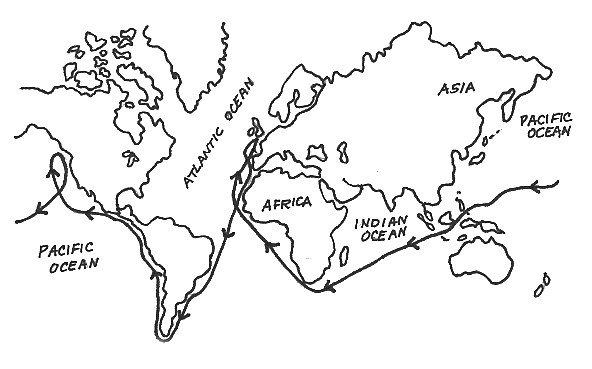| ||||
|
| ||||
|
FRANCIS
DRAKE
 Lived:
1540/41-1596
Lived:
1540/41-1596
Explored California in: 1579
Exploring for: England
Explored: by sea on the northern California coast
Sir Francis Drake’s visit to California is a mystery. Historians have never been able to determine just where he landed on the California coast, and some argue that he did not visit California at all. His name, however, is still linked to the earliest exploration here.
EARLY HISTORY
Francis Drake was born on a farm
just north of Plymouth,
Francis did not go to school. His father taught him to read and write using the Bible. Throughout his life, Francis was a devoutly religious man. He also learned about the sea. When Francis was 10 or 12 years old, he was apprenticed to the captain of a small ship. The boy was a hard worker and a quick learner, and when the captain died, he left his ship to Francis.
BACKGROUND
By the 1560s, Spanish and Portuguese
explorers had crossed the Atlantic Ocean and claimed lands in Central and
South America. The Spanish had conquered the Aztecs and Incas, and were shipping
vast amounts of gold and silver treasure back to
Englishman John Hawkins, a distant cousin of Francis Drake, saw the chance to profit from the slave trade. He raided Portuguese slave ships along the African coast and took the slaves to South America. On his second voyage in 1567-68, Hawkins made Drake captain of one of his ships, the Judith.
While repairing their ships in
the harbor at Vera Cruz (now in
With the blessing of Queen Elizabeth
of
DRAKE’S JOURNEY
The journey that brought Drake
to California began in December 1577 when he set out from Plymouth,
Some reports say that the Golden Hind was 70 feet long and had 18 guns. The hull (body of the ship) was made of two layers of oak wood with sheets of lead between the layers. Besides the seamen and officers in the crew, there were soldiers, gentlemen-adventurers, a shoemaker, a tailor, and musicians to play during dinner. The cabins were finely furnished with carved oak tables and chairs, silk cushions, and silver plates.
Drake captured many Spanish ships and filled the Golden Hind with gold and silver. The Spaniards were afraid of Drake, calling him El Draque, the Dragon. Among his own men, he was seen as a fair and honest leader who treated them well, but he was also demanding.
As Drake sailed further north, he began searching for the Northwest Passage, a water route thought to cross the North American continent. At some point, perhaps off present-day Washington State, he turned back south. His ship was now badly in need of repairs. On June 17, 1579, he landed at 38°30’ north latitude at a sandy bay described as “a convenient and fit harborough.”
The exact location of that bay is not known. Some think it was what is now called Drake’s Bay, just north of the Golden Gate. Others think it was Bolinas Bay, or within San Francisco Bay near San Quentin.
The Golden Hind was pulled up on the beach and its cargo of silver, gold, and jewels was unloaded. The ship was careened (turned on its side) so the seams could be repaired. Drake’s men set up a beach camp surrounded by a wall of earth and stones. They stayed for five weeks.
Coast Miwok Indians living in the area came to see the visitors. Drake and his men visited Miwok villages. The Englishmen exchanged gifts with the Indians, who placed a crown of feathers on Drake’s head. Drake’s group thought the Indians were either worshipping Drake as a god or crowning him as king of their land. Today scholars believe that the Miwok were being respectful, thinking the visitors might be the ghosts of their ancestors.
Before Drake sailed away on July 23, he reportedly put up “a plate of brasse, fast nailed to a great and firme post; whereon is engrauen her graces name, and the day and year of our arrival.” Such a plate was discovered on a beach at the north end of San Francisco Bay in 1936. At first it was believed to be the plate left by Drake, but better testing techniques in 1977 indicated that it was made in modern times. It is not known who planted the fake plate on the beach.
WHAT HE ACCOMPLISHED
Drake claimed the land for England, naming it Nova Albion, or New England. (Albion is the Roman name for England.) He then sailed on across the Pacific, becoming the first captain to sail his ship around the world. The Golden Hind and her 59 remaining crewmen returned to England on September 26, 1580.
LATER YEARS
Drake was knighted by Queen Elizabeth. He became a hero in England, where he lived with his second wife, Elizabeth Sydenham, at Buckland Abbey estate.
Drake made several more pirating trips for England. In 1588 he helped the English gain victory against the Spanish Armada. In 1596, during a raid in the Caribbean Sea, Drake became ill. He died on his ship on January 28 and was buried at sea in his war armor.